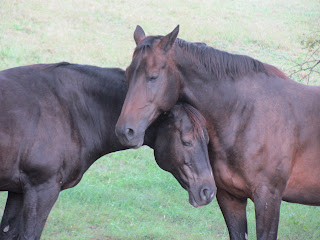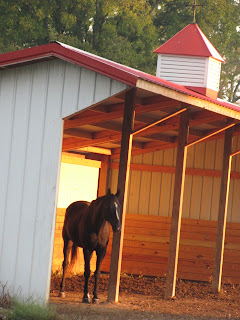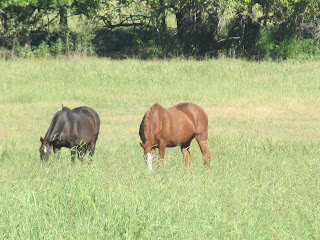Benign neglect is one of many terms that many people use to describe the decision to turn a horse out for a period of time in the hopes that the end result is soundness. Usually this decision is made only after exhaustive attempts have been made to return the horse to soundness. Usually some combination of the following has been done to unsuccessfully rehab a horse: stall rest, surgery of some type, joint injections, shockwave, PRP or IRAP, tildren, chiropractic care, therapeutic shoeing, use of a treadmill or aqua treadmill, very controlled under saddle work, every supplement under the sun, or any other of a number of things. Eventually you run out of things to try, or maybe run out of hope, or are just plain tired of racking up large vet bills to continually be frustrated.
Most vets recommend a year of turnout if all else has failed. Some vets feel that certain aspects of the horse's program needs to be maintained during this time, usually the specific shoeing protocol, and other vets don't. However for all of them the 12 month mark seems to be the magic time frame.
Typically we first meet our clients when they retire a horse with us. They get to know us through this process and realize that we really do provide actual care and the horses are not just running free with no human interaction on the back 40 somewhere. At a later point if they have another horse that has been through a thorough yet unsuccessful rehab they will ask us if the horse can come live with us for a year of "Doctor Green." As space allows we are happy to do this for our clients so at any given time we typically have a few horses living with us whose owners are hoping for a sound, rideable horse after a year or so.
Since the vet(s) involved almost always tell their clients that the 12 month mark is the magic time frame this tends to give the owner involved a skewed idea of what is going to happen during this time frame. In their minds if they look at the horse every couple of months they should see a gradual, linear improvement in soundness.
I've rarely seen it happen this way. Usually what happens is the horse spends the first six months falling apart and regressing to some degree (sometimes a lot, sometimes a little) in soundness. They've typically gone from stall rest to turnout which means their bodies have to adapt to continual low impact movement, they are not being propped up with joint injections, chiropractic care, massages, and anti-inflammatories, and the whole program is just plain different. The horse's exercise and movement can no longer be carefully controlled anymore as they go about the business of being a horse in the pasture. So we typically watch the horse go backwards during the first few months.
After they finish what I call the falling apart phase then they start putting themselves back together. However the putting together phase does not happen in a linear fashion either. They will look a lot better, then seem to regress, then look a lot better, then maybe plateau for awhile. Once this phase is over you hope their final plateau is because they have come sound.
No matter how many times I tell people that you shouldn't even bother to evaluate the horse in the hopes of soundness until the 12 month mark no one ever listens I completely understand why, because at this point they have a lot of time, money and emotional energy wrapped up in the whole process. At the six month mark they are desperate to see how things are going because at this point their hope is that things should looking 50% better. In my experience the horse is just wrapping up the falling apart phase but despite being warned of this the owner is understandably freaked out to see the horse looking worse instead of better.
Given that all of the horses we have watched go through this experience have been unsuccessfully treated for a long period of time by world class vets and farriers with the most current treatments available, the odds are certainly not high from the start that the process will be successful, and it is not always successful. When it does work it is fantastic for all involved, especially since the owner was probably quite disheartened when, despite our recommendation not to, they just had to evaluate the horse at the six month mark (again we understand why they feel the need to evaluate).
In our experience if the horse has not come sound by the 18 month mark then it probably is not going to happen at all. My number one recommendation if you find yourself going the "just be a horse route" as a last ditch effort is don't torture yourself by constantly checking their soundness. Decide what time frame you are comfortable giving the horse (and we do think a year is usually the minimum and 18-24 months the maximum) and then let things be. The odds are good that if the horse does come sound the path it takes to get there will be curvy and random, not tidy and linear.
________________________________
Griselle
Kennedy, Toledo, Johnny and Tiny
Rocky
Largo
Thomas and Chance
Lighty just realized he was all alone and was looking for his friends
once he spotted them he was off in a hurry
Lily and Cuffie
Calimba, MyLight and Cinnamon
Norman and Traveller grooming and hanging out
Homer, Moe and Levendi
Apollo, Hemi and Thomas
























































